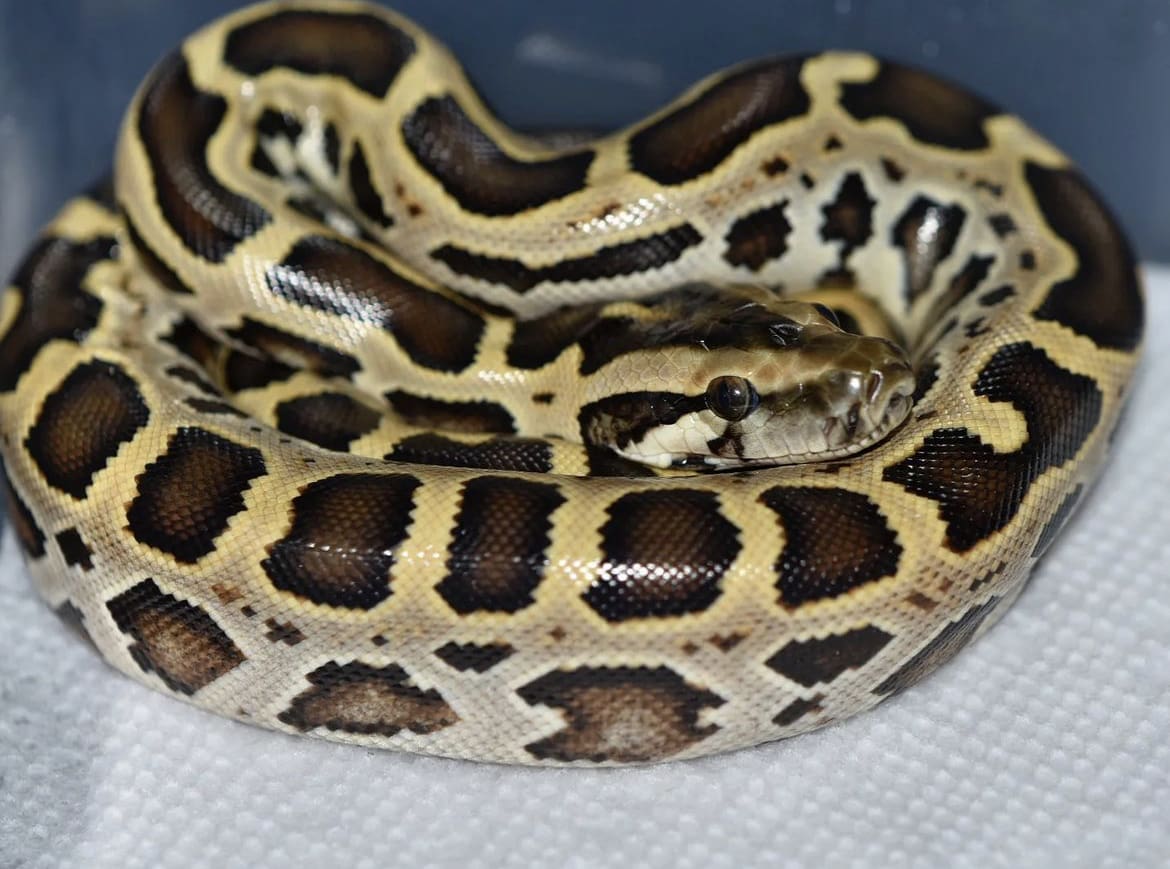Welcome to the realm of the Burmese Python, a creature that commands both awe and a fair bit of space (because, trust me, they’re huge). Let’s embark on this wild ride to unravel the mysteries of one of nature’s most intriguing reptiles. Buckle up!
What is the Burmese Python?
The Burmese Python, known to the nerds as Python molurus bivittatus, is not your average backyard snake. This behemoth slithers through the forests and wetlands of Southeast Asia, flaunting its intricate patterns like the latest high fashion.
But don’t let its exotic looks fool you; this python is more than just a pretty face. It’s a constrictor, which means it hugs its dinner to death. Charming, right? Originally hailing from the lush landscapes of Myanmar, Thailand, and surrounding locales, these pythons have also gatecrashed Florida, turning the Everglades into their own personal Airbnb.
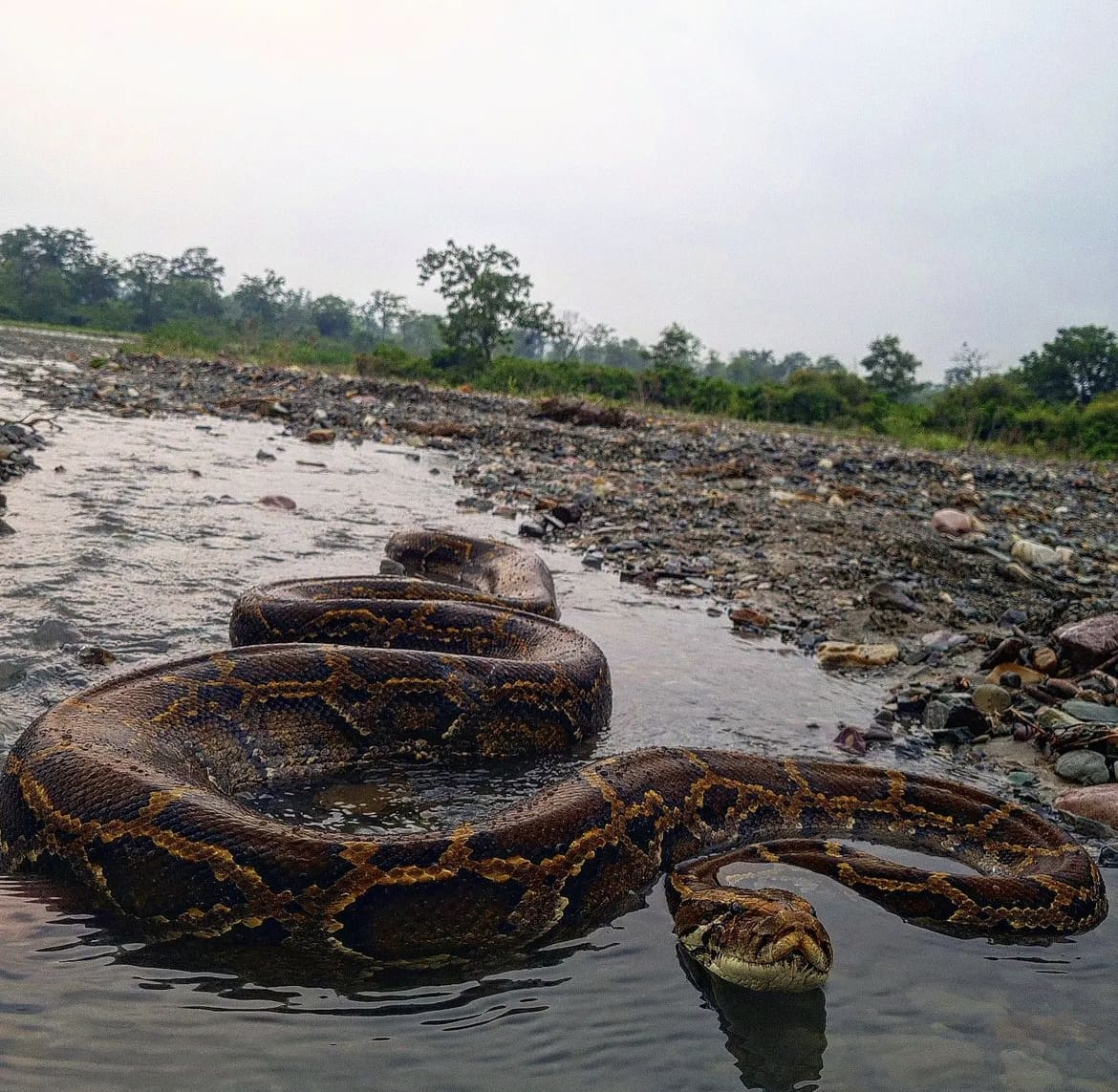
Burmese Python vs Anaconda
So, you’ve heard about the Anaconda, right? The one from the movies, notorious for its size and appetite. Now, imagine it having a distant cousin who’s equally fascinating but slightly less of a diva. That’s our Burmese buddy.
While the Anaconda takes the crown for weight in the snake world, lounging in South American waters, the Burmese Python isn’t far behind, stretching lengths that can rival a school bus. But here’s the kicker: Anacondas are water lovers, while Burmese Pythons are more of the land-and-water combo types, enjoying a dip just as much as a stroll through the forest.
Both have their own style of stealth and strength, but if you’re looking for the one more likely to show up in your exotic pet dealer’s catalog, the Burmese Python takes the cake.
What do Burmese Pythons look like?
Imagine a creature draped in a cloak of beautifully intricate patterns, designed to blend seamlessly into the dense forests and wetlands of Southeast Asia. The Burmese Python is a real-life embodiment of nature’s artistry, with its skin adorned in a mesmerizing mosaic of browns, tans, and blacks. But it’s not just about looks; this design is a masterclass in camouflage, allowing it to lurk unnoticed, waiting patiently for its next meal to wander by. With eyes like glossy beads, fixed in a gaze that seems to pierce through the dense foliage, the Burmese Python carries an air of mystique and raw natural power.
How big are Burmese Pythons?
Alright, size matters when we talk about these reptilian behemoths. Ever wondered what it’s like to stand next to a creature that can easily stretch longer than a limo at a high school prom? Well, Burmese Pythons can grow up to 23 feet long, though most chill around the 16-foot mark. But it’s not just their length; these pythons can weigh as much as a few hundred pounds, making them the heavyweight champs of their domain. Imagine carrying that around all day; no wonder they’re so good at the whole ‘lie-in-wait’ hunting strategy.
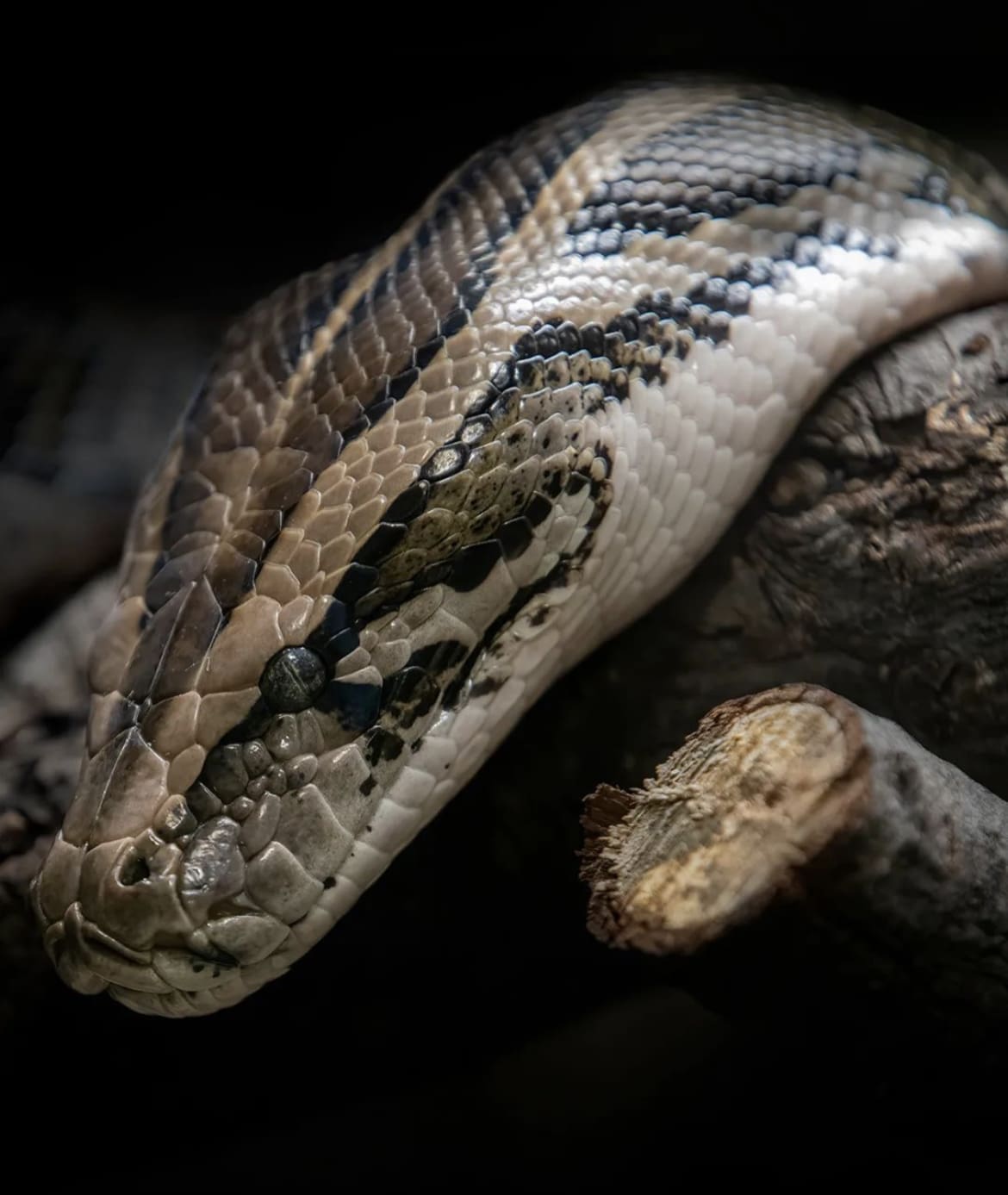
Burmese Python Skin
The skin of a Burmese Python is not just a fashion statement; it’s a survival tool. Their scales have this unique texture that’s both rugged and smooth, perfect for slithering through rough terrain without a scratch. The color patterns—ranging from golds to deep browns, all woven into intricate, almost hypnotic designs—aren’t just for show. They’re the python’s invisibility cloak, blending perfectly with the dappled sunlight filtering through dense forest canopies or the murky waters of a swamp. And when they shed, it’s like watching a creature reborn, leaving behind a ghost of its former self.
Burmese Python Tails
Unlike some of their reptilian cousins who might use their tails for balance or even combat, the Burmese Python’s tail is more about finesse. It’s the final flourish on their already impressive length, tapering to a point that seems almost delicate in comparison to their muscular build. But don’t be fooled; this tail is a crucial tool, aiding in their swimming prowess and providing that extra grip when they’re coiling around their next meal. It’s the unsung hero of their anatomy, ensuring they glide through water as gracefully as they navigate the forest floor.
Burmese Python Tongue
Let’s talk about that iconic flicker—the Burmese Python’s tongue. It’s not just for show or to give you the heebie-jeebies. This forked wonder is a high-tech sensor, picking up chemical cues from the air like the latest gossip on the reptilian grapevine. It’s how they taste the air, catching the scent of potential meals or the subtle perfume of a mate in the breeze. Each flick sends information back to their Jacobson’s organ, essentially turning their tongue into a roadmap to their next big adventure. It’s like having Google Maps but for smells, guiding them through their murky, wild world.
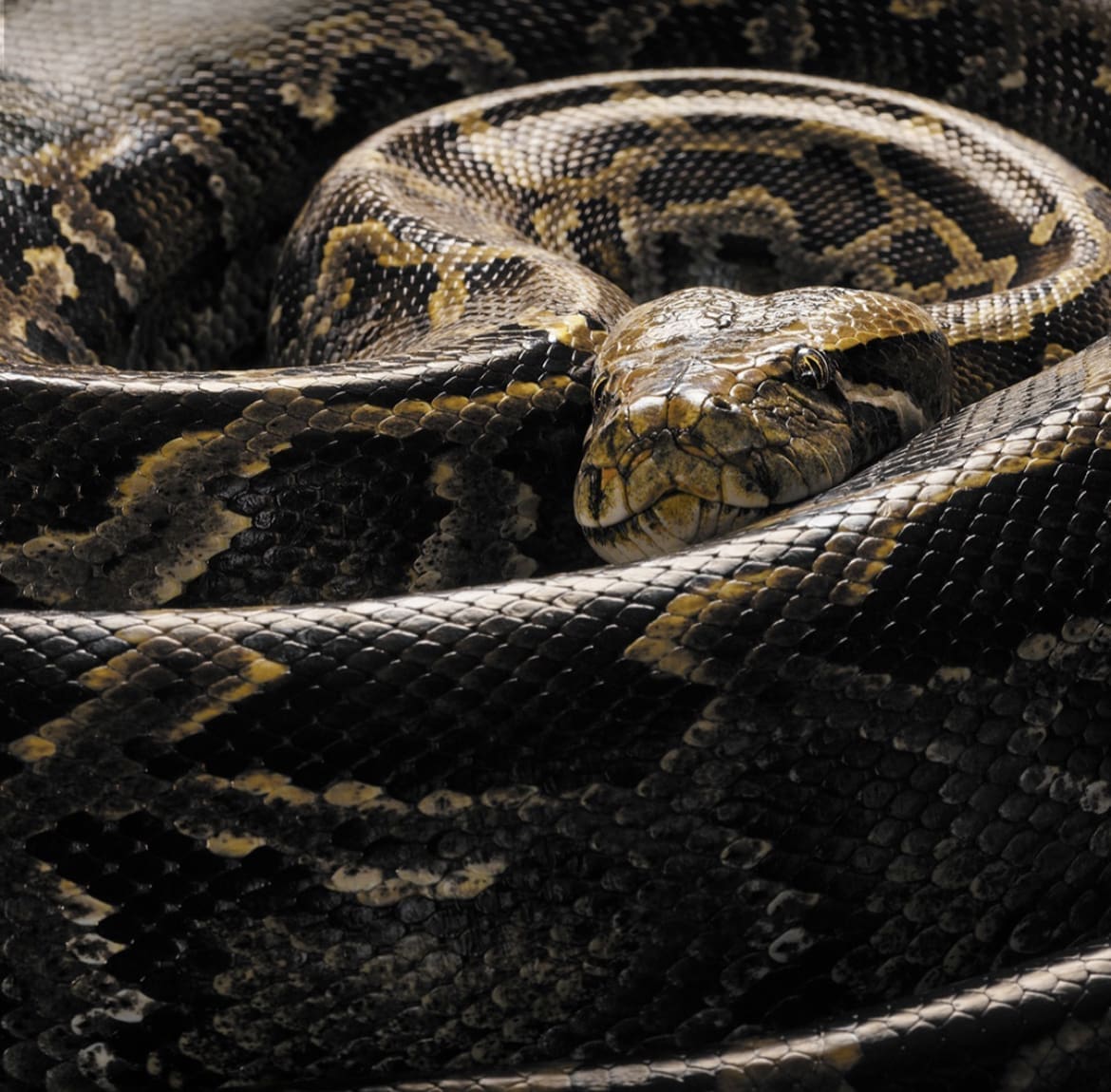
Burmese Python Coloration
Now, onto the kaleidoscope that is the Burmese Python’s skin. Their coloration is a masterclass in Mother Nature’s artistry, with each python sporting a unique pattern that could give the most extravagant tapestries a run for their money. These patterns aren’t just for decoration; they’re a testament to the python’s adaptability, offering camouflage among leaves, dirt, and shadows. From golden yellows to deep, earthy browns, these colors serve as their stealth mode, making them nearly invisible to both prey and predators. It’s their own natural invisibility cloak, allowing them to thrive in plain sight.
What do Burmese Pythons eat?
If you’ve ever wondered what’s on the menu for a creature that can unhinge its jaw, wonder no more. Burmese Pythons are not picky eaters. These constrictors feast on a buffet ranging from small mammals to birds, and for the more ambitious ones, even deer or alligators. Yes, you read that right.
Their dining habits are a testament to their role as apex predators, capable of taking down meals several times their own size. They employ a simple yet effective strategy: ambush, constrict, then swallow whole, a process that is both fascinating and a bit macabre. It’s a wild world out there, and in the Burmese Python’s case, dinner is served in the most dramatic fashion imaginable.
Do Pythons Eat Alligators?
While it might sound like a scene from a reptilian showdown, Burmese Pythons have been known to take on alligators, albeit rarely. These epic battles typically involve smaller gators or juveniles, as adults are less vulnerable to python attacks due to their thick, armored hides and brute strength.
Yet, these encounters showcase the python’s incredible power and adaptability as top predators in their native habitats. So, if you find yourself in the marshes of Florida or the swamps of Southeast Asia, keep your eyes peeled—you might witness a showdown like no other.
@jayprehistoricpets
Do Burmese Pythons eat people?
And now, the million-dollar question: do Burmese Pythons eat people? Let’s not beat around the bush—incidents involving pythons attacking humans are exceedingly rare. These creatures prefer prey they can easily overpower without much fuss, and humans are not on their usual menu. Attacks on humans are almost unheard of in their natural habitats and usually involve captive snakes and unfortunate circumstances. So, while it’s essential to exercise caution and respect towards these powerful animals, the fear that they’re out hunting for humans is more fiction than fact.
Burmese Python Social Structure
When you think of social butterflies, Burmese Pythons probably aren’t the first critters that pop into your mind. And you’d be right—these reptiles are more lone wolves of the jungle. They don’t throw tea parties or mingle at social gatherings; instead, they prefer the solitary life, coming together only when it’s time to make more little pythons. This isn’t to say they’re complete hermits; during colder months, they might share a sunny spot or a cozy cave to keep warm, but it’s more about convenience than companionship. Think of them as the introverts of the animal kingdom, needing plenty of alone time to recharge their batteries.
How do Burmese Pythons reproduce?
The love life of a Burmese Python could give any soap opera a run for its money. It all starts with the male’s pursuit, which involves picking up on the female’s scent trail. Once he finds her, the courtship begins, and it’s not just a one-night stand. Males might have to compete, engaging in a wrestling match of sorts, striving to impress without causing harm. The female then lays a clutch of eggs, which she fervently guards and incubates by contracting her muscles to generate heat. It’s maternal care at its most reptilian, showcasing a tender side to these formidable creatures.

How long do Burmese Pythons live?
How long do these giants roam the Earth? In the wild, a Burmese Python can live up to 20 years, a respectable lifespan for such a large predator. In captivity, where threats are minimal and meals are guaranteed, they can stretch that to 25 years or more. It’s a long time, especially considering the size and complexity of these creatures. Their longevity is a testament to their resilience and adaptability, thriving in environments from dense forests to murky swamps.
Are Burmese Pythons aggressive?
Busting myths left and right, let’s get one thing straight: Burmese Pythons are not the villains of the animal kingdom. These creatures are generally not aggressive towards humans. They’re more of the ‘mind-my-own-business’ type, preferring to avoid confrontation unless provoked or threatened. Most of the time, they’d rather slink away than engage. However, like any wild animal, they will defend themselves if they feel cornered or if a clumsy human steps too close to their personal bubble. So, if you ever find yourself face to face with one, remember: respect their space, and they’ll respect yours.
Are Burmese Pythons territorial?
In the grand scheme of things, Burmese Pythons aren’t as territorial as some of their reptilian cousins. They don’t have a fixed ‘no trespassing’ zone that they guard with slithery diligence. Instead, they have preferred hunting and basking areas that they frequent, but they’re not about to throw down over a sunspot. Their nomadic nature means they roam far and wide in search of food, warmth, and mates, making the concept of a fixed territory somewhat fluid. However, during breeding season, males might get a bit more possessive, but it’s more about competing for a potential mate than defending a specific piece of real estate.
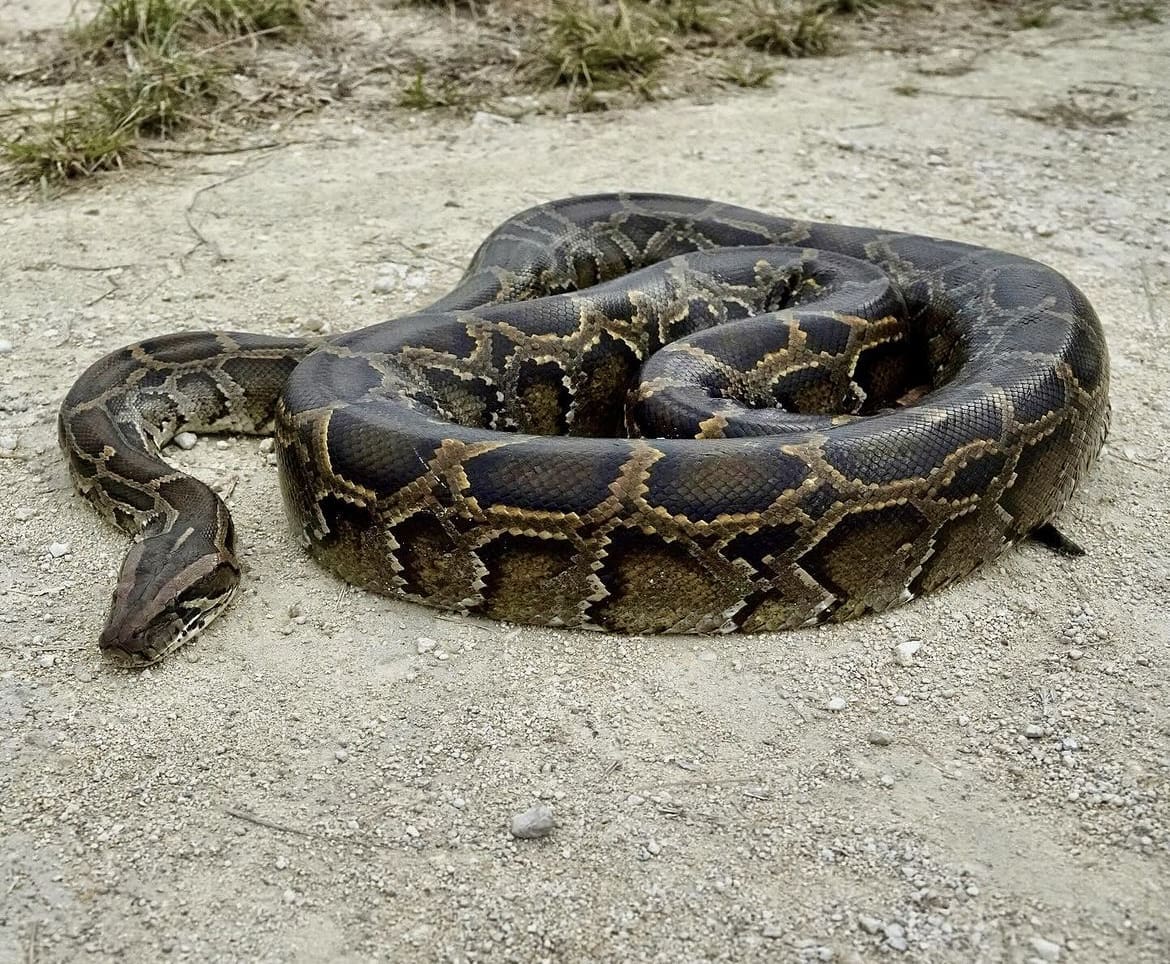
Burmese Pythons as Pets
Let’s talk about Burmese Pythons as pets. These stunning serpents have captured the fascination of many reptile lovers, but owning one comes with significant considerations. Firstly, their size. Burmese Pythons can reach lengths of over 20 feet and require spacious enclosures with secure locks.
Feeding them is another factor. They have hearty appetites and need a diet of appropriately sized prey, which can be costly and time-consuming. Their potential for danger should also be noted. While generally docile, they can pose risks with their powerful jaws and constricting capabilities, requiring careful handling and supervision.
Lastly, owning a Burmese Python may be subject to legal restrictions due to concerns about them becoming invasive species if released into the wild.
Where do Burmese Pythons live?
Burmese Pythons, true to their name, hail from the lush landscapes of Southeast Asia. Their real estate choices range from jungles and marshes to grasslands and even rocky foothills. These snakes are not picky about where they crash as long as it’s near water and there’s enough cover to conduct their stealthy business. Originally from countries like Myanmar (Burma), Thailand, Vietnam, and parts of Indonesia, these pythons have also become infamous residents of the Florida Everglades, where they’re considered invasive. Their adaptability is impressive, but it’s also causing ecological headaches in places where they don’t belong.
How many Burmese Pythons are there in the wild?
Counting snakes is not exactly an easy job, especially when they’re as elusive as the Burmese Python. In their native range, precise numbers are hard to come by, thanks to their stealthy nature and vast, inaccessible habitats. However, it’s known that their populations are declining in the wild, primarily due to habitat loss and hunting for their skins and other body parts. In contrast, in places like the Florida Everglades, their numbers are booming, with estimates ranging from tens of thousands to potentially over 100,000, creating an ecological imbalance.
Are Burmese Pythons endangered?
The conservation status of the Burmese Python is a tale of two stories. In their native Southeast Asia, they’re considered Vulnerable by the IUCN Red List, facing threats from habitat destruction, poaching for the exotic pet trade, and hunting for their skins. Their situation is a stark reminder of the delicate balance ecosystems maintain and how human activities can tip the scales. On the flip side, their booming population in non-native habitats like Florida poses a significant threat to local wildlife, prompting efforts to control their numbers and protect the indigenous species.
Threats to Burmese Pythons in the Wild
Despite their formidable size and adaptability, Burmese Pythons face a myriad of threats in their natural habitats. Habitat loss and degradation due to human activities such as deforestation, urbanization, and agriculture are significant concerns. As forests are cleared for development or converted into agricultural land, the pythons lose crucial hunting grounds and breeding sites. Additionally, they’re often targeted by poachers for their skins, which are highly valued in the fashion industry, leading to illegal hunting and trade.
In areas where they’ve been introduced as invasive species, such as the Florida Everglades, Burmese Pythons pose a serious threat to native wildlife. With their voracious appetites and lack of natural predators, they can decimate populations of small mammals, birds, and reptiles, disrupting delicate ecosystems. This has prompted efforts to control their numbers through removal programs and public awareness campaigns, but the task is daunting given their elusive nature and prolific breeding.
Where to See Burmese Pythons In the Wild
For the adventurous souls eager to catch a glimpse of these majestic creatures in their natural habitat, Southeast Asia offers some prime snake-spotting opportunities. Countries like Myanmar, Thailand, and Indonesia boast diverse ecosystems where Burmese Pythons thrive. National parks and wildlife reserves provide protected areas where visitors can observe these reptiles from a safe distance, either in the wild or at designated conservation centers.
In regions where Burmese Pythons have become invasive, such as Florida, organized snake-spotting tours offer a chance to witness these giants in action. However, it’s crucial to prioritize safety and respect for the environment during these excursions, as encounters with wild pythons can be unpredictable. Local authorities and conservation organizations often provide guidelines for responsible wildlife viewing to minimize disturbances to both the pythons and their habitats.
Tips for Spotting Burmese Pythons
If you’re itching to embark on your own Burmese Python safari, here are a few tips to enhance your chances of success:
- Choose the Right Time and Place: Research the best times of year and locations for python sightings, taking into account factors like weather, breeding seasons, and habitat preferences.
- Be Patient and Observant: Snakes are masters of camouflage, so keep your eyes peeled for subtle movements or patterns that might give their presence away. Patience is key; sometimes, you’ll need to wait quietly for them to emerge from hiding.
- Respect Their Space: Remember, you’re a guest in their home. Keep a safe distance and avoid disturbing their natural behavior. Never attempt to handle or approach a wild python, as it can be dangerous for both you and the snake.
- Travel with a Guide: If you’re unfamiliar with the local terrain or wildlife, consider joining a guided tour led by experienced naturalists. They can offer valuable insights and ensure your safety while maximizing your chances of spotting pythons.
Facts about The Burmese Python
- Burmese Pythons are one of the largest snake species in the world, capable of reaching lengths of over 20 feet.
- They’re ambush predators, relying on stealth and surprise to capture their prey, which includes mammals, birds, and even other reptiles.
- Unlike venomous snakes, Burmese Pythons kill their prey by constriction, squeezing them until they suffocate.
- These snakes have heat-sensing pits on their faces, allowing them to detect the body heat of potential prey, even in darkness or dense vegetation.
- Burmese Pythons are excellent swimmers and can remain submerged for extended periods, making them equally at home in water as on land.
Myths about The Burmese Python
- Myth: Burmese Pythons are aggressive man-eaters.
- Reality: While they may defend themselves if threatened, attacks on humans are extremely rare, and they typically avoid confrontation.
- Myth: Burmese Pythons are harmful to the environment.
- Reality: While they can disrupt ecosystems in non-native habitats, they play a vital role as apex predators in their native range, helping to regulate prey populations.
- Myth: Burmese Pythons are easy to care for as pets.
- Reality: Keeping a Burmese Python as a pet requires specialized knowledge, proper housing, and a commitment to their long-term care. They can live for decades and grow to be quite large, posing challenges for inexperienced owners.

